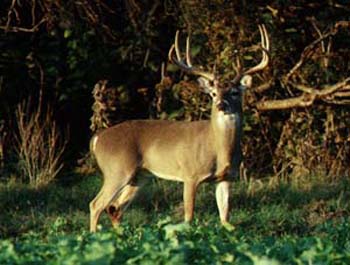The white-tailed deer is the most popular big game species in the United States. Landowners and ranch managers are becoming more interested in intensive deer management strategies including supplemental food plots in order to conserve and further enhance deer populations, in some cases in areas with rapidly decreasing amounts of deer habitat. The establishment of supplemental food plots can be an important deer management strategy which has become widely accepted throughout the southeastern part of the U.S. out to east Texas.
However, it should be noted that most plot plantings are not aimed at improving nutrition of white-tailed deer despite the fact that much of the southeastern deer range provides substandard nutrition for quality deer production. This is compounded by the fact that often times the number of deer (deer density) is greater than the number of animals the habitat can support under optimal body and antler growing condition.
The use of supplemental food plots as an intensive management tool evolved from hunters’ efforts to concentrate deer in one area for harvest. Thus, it is important to distinguish between “food plots” and “hunting plots,” although they could be one in the same assuming the plot provides real nutrition for animals not harvested. Keep in mind that it is just as important to use plots to improve nutrition of whitetails and add critical minerals, particulary calcium and phosphorus, to the diet of a deer herd.
In the southeast U.S., the amount of rainfall is sufficient to produce consistent crops of supplemental forages. However, abundant rainfall is a mixed blessing when managing for deer habitat as it quickly leaches nutrients from the soil, which lowers the quality of food supplies. But because of rainfall, combined with proper fertilization, the planting food plots is a sound component in managing white-tailed deer in this area. Where rainfall is less abundant or where semi-arid conditions exists, food plots may not be feasible on a yearly basis unless a local water supply is available. Keep these general concepts in mind when thinking about your next food plot endeavor.


It seems like everytime I attempt to put in a food plot, it doesn’t really work. What is the deal?
Well, a lot of things could be at play. First, make sure that you are in proper soil type for the seed types you are planting. Second, get a soil test. This is simple, but very important. Next, make sure you prepare you seedbed adequately and get good seed to soil contact. Lastly, hope it rains or irrigate.
I have the same problem that many seem to have. I plant good seed and fertilize and lime according to soil tests, but even so the plots do minimally. I also prepare a good seed bed and make sure of good seed to soil contact. Plants start to come up but do not go much farther. The only other thing I can think of is rainfall. We have received less than normal rainfall for Southeast Alabama for a couple of years. Any comments or help would be appreciated.
Charles, drought has been one of the biggest problems with food plots since they were invented. Food plots are great when it rains, but they fail miserably when it is dry—and that is when the deer really need them! Even the professionals have difficulty predicting the weather, so don’t feel too bad about about your less than stellar food plot. All you can do is prepare as much as possible and and hope for the best.
Landowners interested in deer management should focus on habitat management first, then add food plots or protein pellets as a supplemental kicker. Maintaining proper deer density and good habitat ensures that deer do okay, even during periods when it does not rain. Good luck!
I would place an “exclusion cage” in the food plot to test utilization by wildlife/livestock. I have been astonished by how much usage occurs of which I wasn’t aware until we put the cages in place.
The new pasture/plot scouting cameras would also be beneficial in observing animal utilization.
Soil testing and fertilizing – make sure your test includes minor elements and your fertilizer includes the required minor elements. They aren’t very “minor” if lacking and the particular plant needs it. Also, if legumes are specified when running the soil test, the test may not recommend any Nitrogen. If you are planting only legumes, you should rarely need additional Nitrogen but you need to make sure the seeds are inoculated. If you are planting a blend or mixing non-legumes in, I would make sure to add some Nitrogen.